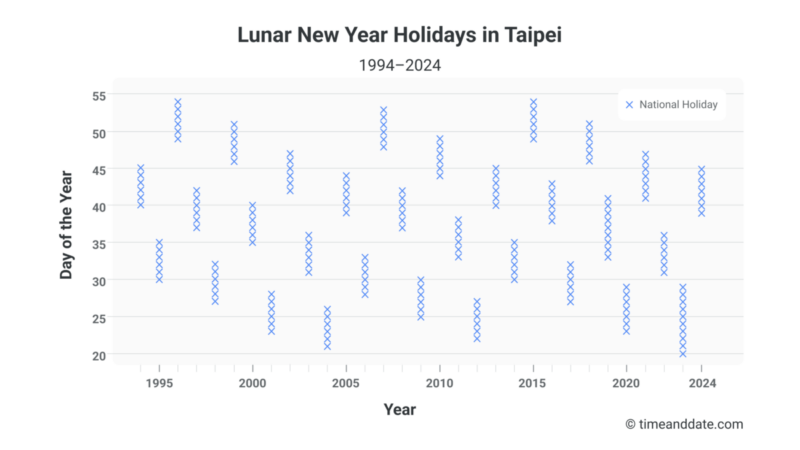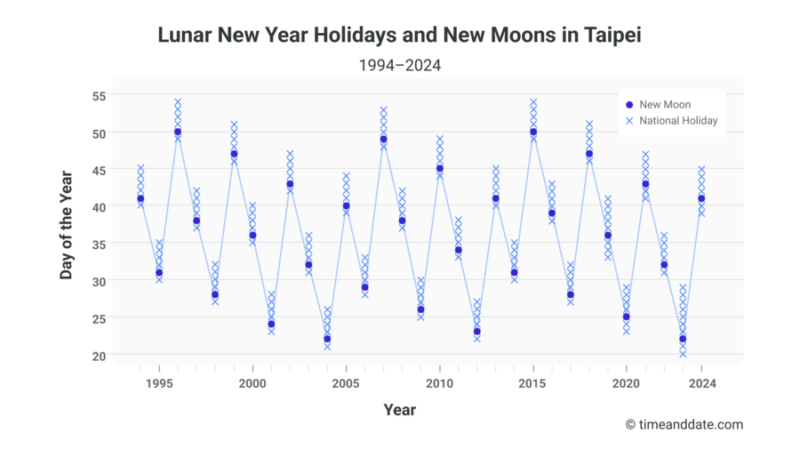
TimeandDate published this original article by Georg Rehberger on February 6, 2024. Used with permission. Edits by EarthSky.
2024 Lunar New Year
Billions of people celebrate the Lunar New Year and have to keep up with its shifting date. In 2024, the lunar year starts 19 days later than in 2023. The culprit? Hiding in the sky.
Many of us have already forgotten about our New Year’s resolutions, while billions of people haven’t even gotten to the fireworks yet: The new year in East Asia and for many Asian communities around the world begins on February 10, 2024.
Known as Spring Festival in China, Tet in Vietnam, and Seollal in Korea, the Lunar New Year celebration marks the first new moon in the Chinese lunisolar calendar, a system that integrates lunar phases and solar years.
2024 lunar calendars on sale now. Makes a great gift! Order here.
The dragon follows the rabbit
February 10, 2024, ushers in the Year of the Dragon in the Chinese zodiac cycle. It follows the Year of the Rabbit that began on January 22, 2023. The difference between last year’s date and this year’s date is 19 days.
Why is that? The Lunar New Year date relies on the moon. Since moon cycles are shorter than calendar months, the date for any specific new moon (like the first new moon) shifts every year. But is the new moon in question really 19 days later than last year? The answer lies in the way the Lunar New Year’s date is calculated.
How to calculate the Lunar New Year
The Lunar New Year is both connected to the beginning of spring in the Chinese calendar (February 4 or 5) and to the new moon.
The date for the Lunar New Year therefore has to follow the date of the new moon closest to February 4 or 5. To find the exact date, you can follow three simple rules:
- Find the new moon phases for your location between the December solstice and the March equinox. You basically look at the new moons in January, February and March.
- Find the new moon that is closest to February 4 or 5, symbolizing the beginning of spring in the Chinese calendar (Lìchun).
- Make sure the Lunar New Year date falls between January 21 and February 21. Otherwise, it would be too early or too late for the beginning of spring in the Chinese calendar.
Example: 2024 Lunar New Year in Taipei
Let’s calculate this year’s date for Taipei.* You can easily look up moon phases for your location here. The new moon dates for 2024 in Taipei are:
- January 11, 2024
- February 10, 2024
- March 10, 2024
The closest new moon to the Chinese spring date on February 4 or 5 is the new moon on February 10. Not only is this the closest moon phase, but both remaining moon phases are either before January 21 or after February 21, disqualifying them from being Lunar New Year dates.

The graph above shows all dates for the Lunar New Year celebrations in Taipei* for the last 30 years. You can see that the dates shift backward in the calendar (downward in the graph) from year to year, only to jump forward (or up) again, usually after three years.

The cyclical nature of the Lunar New Year becomes clearer by looking at the new moon phases. The graph above shows the new moons in Taipei between January 21 and February 21. The new moons align perfectly with the Lunar New Year celebrations and show the marriage of lunar holidays with the solar calendar.
Next year’s date is 12 days earlier
The Lunar New Year date will often be 11 or 12 days earlier than the previous year, unless the new date would be earlier than January 21. For example, Lunar New Year 2025 will be 12 days earlier than this year, on January 29.
The year after, in 2026, the date can’t move any earlier, since it would be before January 21. Thus, the Lunar New Year will jump ahead to February 17, 2026.
Bottom line: The reason the 2024 Lunar New Year falls so late is the date of new moon and how it aligns with spring in the Chinese calendar.
* We selected Taipei to show the holiday data because the Lunar New Year holidays there are the most consistent in our database over the last 30 years. The moon phases are also shown for Taipei to keep everything in the same time zone.

